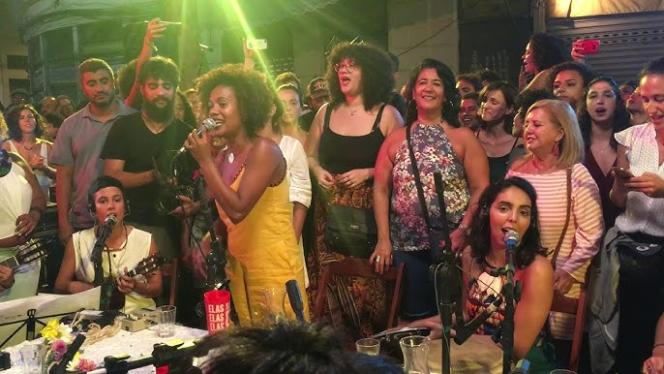LETTER FROM RIO DE JANEIRO
This Friday evening at the end of July, a tropical downpour fell on Rio de Janeiro. Not enough to discourage the small crowd of revelers, who rush to the entrance of Beco do Rato (in French, “the alley of the rat”), a famous samba club in the Lapa district. On the walls, the owners have painted the faces of the gods of the most famous musical genre in Brazil: Noel Rosa, Pixinguinha, Donga, Ubirany, Cartola, Moacyr Luz, Aldir Blanc… All men.
And yet: on stage, singing as well as guitar, surdo, cavaquinho and agogo, there are only women. Delighted, the room undulates, vibrates, sings its favorite hits at the top of its lungs. Among them, Daughters of Oya, homage to an Afro-Brazilian deity, formidable warrior queen, sovereign of lightning and storms. A symbol of resistance… and like a challenge to male musicians whose smiles line the partitions.
“Our music is an act of political resistance against misogyny”proudly claim Silvia Duffrayer, Barbara Guimaraes and Cecilia Cruz, three thirty-year-old founders of this group entirely composed of women, called Samba Que Elas Querem (“the samba they want”). “Tired of being reduced to sexualized objects! We want to show that we are professional musicians, just like men.”they explain in unison.
The approach is anything but obvious, because, in Brazil, samba was for a long time an art reserved for men (in Portuguese, the word itself, oh sambais also written symbolically in the masculine). “When the band was founded in 2017, we got a lot of scornful comments, like ‘we’re going to come see you because you’re pretty, even if you’re not very talented'”remembers Cecilia Cruz.
Raw and sometimes violent misogyny
Originally, however, the place of women was preponderant in samba. The musical style was born at the end of the 19the century in Rio in the port districts of Saude, Gamboa and Santo Cristo, where former slaves from the Northeast live. In these communities, the figure of the tias bayanas (“Bahian aunts”), true matriarchs, priestesses ialorixas religions of African matrix and organizers of big parties in their house, at the bottom of their garden: the famous quintal.
“They are the ones who invented the samba. THE Bayanas compose the melody, play all the instruments, sing and lead the bands”explains Leonardo Bruno, author of the book Canto de rainhas (“Chant des reines”, Agir, 2021, untranslated) devoted to the place of women in samba. The best known, Tia Ciata, born in 1854, dances the miudinho (“feet together”) wonderfully and brings together cult musicians, such as Pixinguinha, Donga, Joao da Baiana and Sinhô, at her home.
You have 61.56% of this article left to read. The following is for subscribers only.
